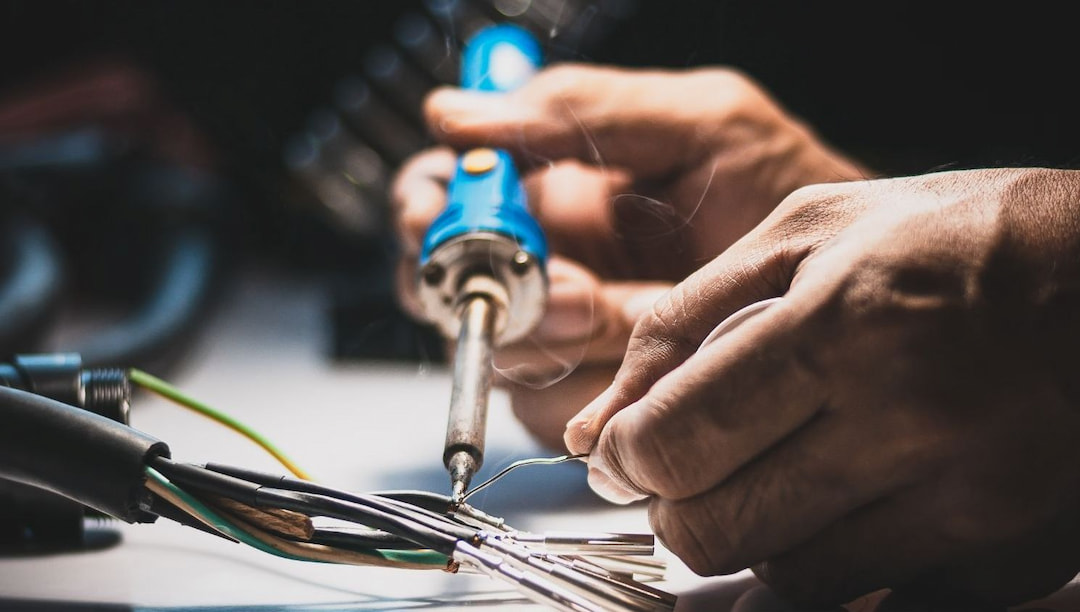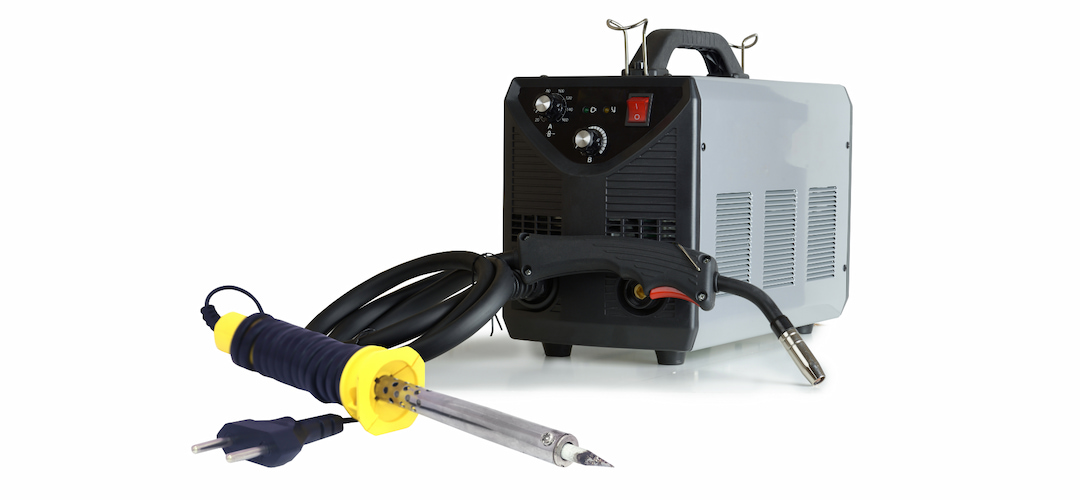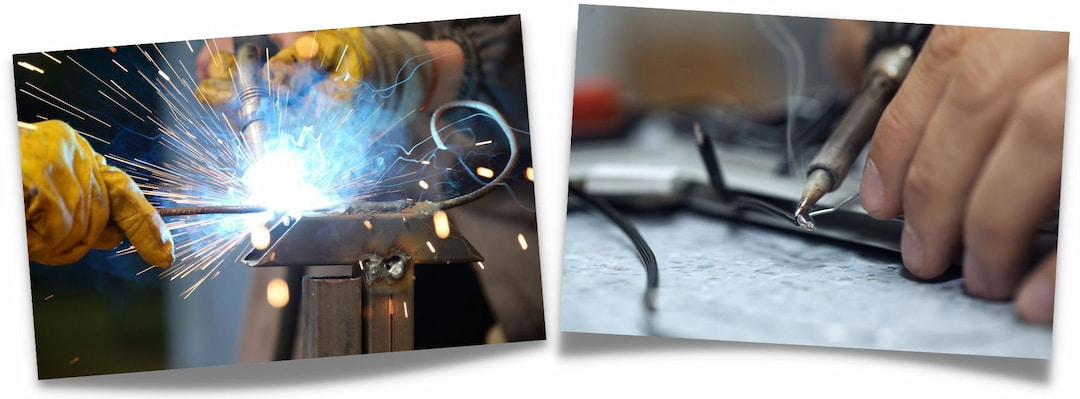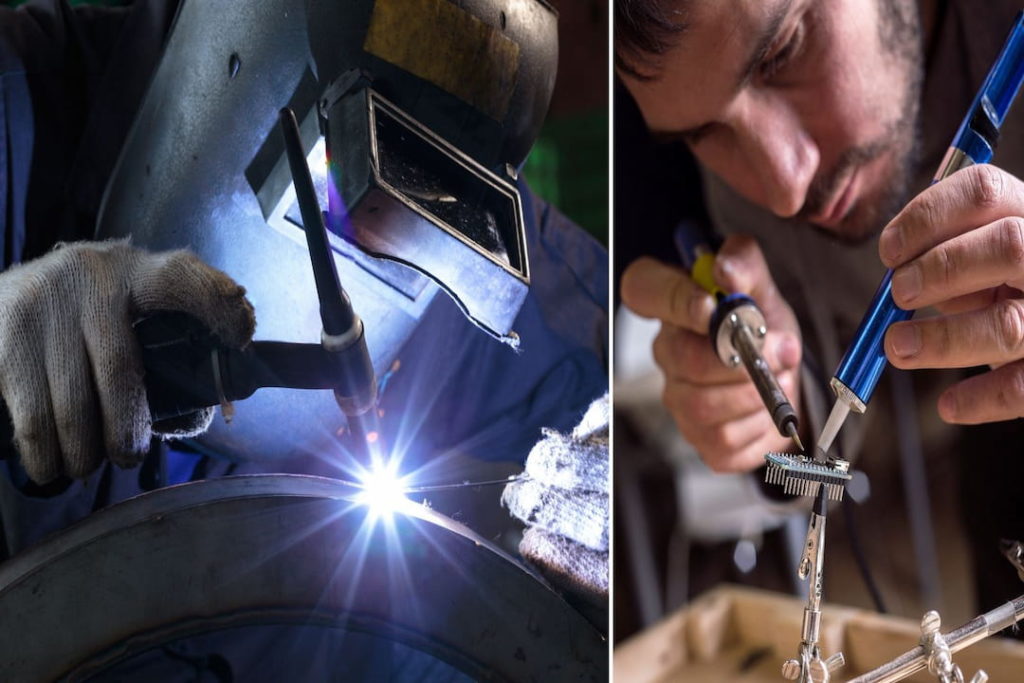In this blog post, we’ll take an in-depth look at both welding vs soldering to compare and contrast their differences, similarities, uses cases, tips & tricks for beginners, and safety concerns you should be aware of when taking part in either process!
Table of Contents
Welding and soldering are completely different yet surprisingly similar processes with a wide variety of applications. Both welding and soldering involve joining metals together permanently and creating complex shapes. However, the materials utilized in each process differ greatly.
How Does Welding Join Metal?
Welding is a form of metal joining that uses heat to liquefy and fuse two pieces of metal into one piece. The process can be completed using either an electric arc or a gas-fuelled flame, depending on the welding type. Generally speaking, when welding, the metals are heated until they reach a molten state and then allowed to cool, solidifying them into one piece.

How Does Soldering Join Metal?
Soldering is a relatively low-temperature process used to join metals by melting and flowing a filler metal, known as solder, into the joint. Solder is an alloy typically consisting of tin and other metallic elements such as lead or copper. When heat is applied to the solder, it melts and becomes liquid, which flows into the joint between the two metals, binding them together. Soldering is often used when connecting electrical components or small parts and can be completed using a soldering iron, torch, or another heating element.

Different Techniques Used in Welding and Soldering
When it comes to joining metals, various techniques are used in welding and soldering. Soldering is usually done with a soldering iron heated up to the solder's melting point, allowing it to form a secure joint between two pieces of metal. Unlike welding, there is no need for high heat or pressure when soldering as the solder melts at a much lower temperature.
On the other hand, welding is a much more complex process involving heating the metal to its melting point and then applying pressure to form a secure joint. It's also a lot more expensive as you will need a specialized welding machine based on the metals you need the weld.
You will need to consider good MIG welders and get one that fits your budget. Alternatively, you can get started with the best stick welder for beginners.
A good choice would be to get a combo welder that can do several processes. You will still need welding rods or wire as well as shielding gas in case of gas arc welding processes like GMAW: MIG (Metal Inert Gas) welding, MAG (Metal Active Gas) welding, and GTAW: TIG (Tungsten Inert Gas) welding.
TIG (Tungsten Inert Gas) welding. Arc welding is one of the most popular forms of welding and usually utilizes electric current to generate an arc that welds two pieces of metal together. This form of welding is usually used for heavier metals and requires a more intense heat than soldering.
Another option is to get the best flux core welder that doesn't break the bank so that you can work outdoor and save on shielding gas.
Where you cannot save money is a the best welding helmet to protect your eyes and also help you do a good job even if you are a novice welder.
Yeah, it's definitely way more expensive than getting a soldering iron and some solder. Still, you cannot mend your exhaust pipe or a fence with a soldering iron.
On the other hand, you can't fix your retro TV set with a stick welder, either. 🙂 So, every job needs the right tool, regardless of the price.

Types of Materials That Can Be Welded or Soldered
Welding and soldering both involve joining different metals, but the type of materials that can be used varies significantly between the two processes. A filler material is added to the base metal when welding to create a strong bond between the two pieces.
This filler material often consists of the same metal as the base metal, but there are also options for welding dissimilar metals together. When soldering, a filler metal is used to bond two different metals, and this material often consists of a different alloy than the base metal. Commonly used filler materials include tin-lead, cadmium-silver, cadmium-zinc, silver-copper, aluminum-silicon, and zinc,-aluminum alloys.
Base Metal and Corresponding Solder Chart
Base Metal | Solder |
|---|---|
Copper and copper alloys Mild steel Galvanized metal | Tin-lead |
Copper and copper alloys Mild steel | Tin-antimony |
High strength for copper and copper alloys Mild steel Stainless steal | Cadmuium-silver |
Aluminum and alluminum alloys | Cadmium-zinc |
Although welding and soldering are designed to join different metals, the type of joint created will differ depending on the process used. Let's take a quick look at the pros and cons of welding and soldering.
Pros of Welding:
Cons of Welding:
Welding joints are designed to create a strong and permanent bond between the two metals, while soldering joints are typically weaker but more flexible than welding joints. This flexibility makes it ideal for applications that require some give, such as plumbing or electrical work.
Pros of Soldering:
Cons of Soldering:
Application of Welding vs Soldering
The application of welding versus soldering will depend on the job at hand and the desired outcome.
Welding is a process in which heat, pressure, or both combine two metal components. This is most commonly accomplished through arc welding, wherein an electric current is passed between two electrodes to generate enough heat to reach the melting point of the metals being joined. With MIG and TIG welders, you will need the appropriate mixtures of shielding gases.
In addition, preheating treatment and filler material may also be used in the welding process to ensure a good bond between the two components.
Soldering is done at a much lower-temperature than welding, generally involving joining metals with an alloy (such as lead or tin). Soldering may be done at a temperature below 840°F while welding reaches temperatures of roughly 10,000°F.
Welding results in much stronger joints than soldering. This makes it suitable for load-bearing and structural metal joints. Soldering results in a connection that is only as strong as the solder you use.
Since some folks may be interested in welding vs brazing, we dedicated a separate short guide to that, as well.

FAQs
Why is welding stronger than soldering?
Welding is stronger than soldering because it involves melting metal and joining them together, creating a very strong bond. Soldering, on the other hand, relies on electrical resistance between two pieces of metal for its strength.
The bond created by welding is much more permanent and secure than that created by soldering joints. Furthermore, welded joints are also more resistant to environmental elements such as corrosion and temperature changes, which makes them much more durable in the long run.
Which welding is strongest?
Gas metal arc welding (GMAW) is usually the strongest type of weld for metals such as steel and aluminum, while gas tungsten arc welding (GTAW) is typically better suited to alloys and high-temperature applications. Fusion welding methods, such as oxyacetylene and laser beam welding, can also provide strong welds but are rarely used for general applications.
In some cases, the strongest weld joint may be achieved through a combination of welding processes. It’s important to consider the properties and characteristics of the joined metals when determining which type of weld will yield the strongest results.
Which is better, soldering or welding?
The answer to this question depends on the materials being joined and the type of jobs. However, both soldering and welding can be used to create strong, reliable joints in different applications.
Soldering is typically used for joining two dissimilar metals that need to be stronger to be welded. It involves using filler material, such as solder, and a heat source, such as a propane torch or soldering iron. Soldering is super-useful for joining sensitive parts in various electronic devices.
Welding is a stronger method of joining two pieces of base metal in which the materials are melted together at higher temperatures. It is typically used for joining metals with similar properties, like steel or aluminum in numerous applications: pipe welding, underwater welds, automotive, structural projects and a lot more.
